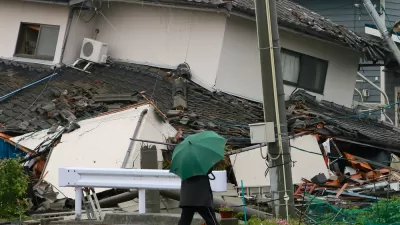Buildings constructed of unreinforced masonry get much if not most of the media's attention on seismic safety, but so-called 'soft story' wood buildings, often with garages on the ground floor, compose the greatest numbers of vulnerable buildings.
The August 24, 6.0 earthquake centered in Napa, Calif. may have caused $1 billion worth of damage and may also shake up state and city lawmakers to do more to reinforce vulnerable buildings. We look at both both unreinforced masonry and soft story buildings from a Bay Area perspective. Only one type has state law addressing retrofit.
"Although a 1986 state law mandates that local government identify unreinforced-masonry buildings, what the cities do about the problem is up to them. Some have mandatory compliance rules, while some make them voluntary," write Carla Marinucci, John Coté and J.K. Dineen of the San Francisco Chronicle.
As a result, safety is "still a bit of a piecemeal" from city to city, Hutchings Mieler said. "Local governments approach it all very differently - and even in the Bay Area, we have very different standards, city to city and county to county.
Contrast San Francisco's mandatory approach with Oakland's voluntary one.
- San Francisco has pursued legal action against some property owners over their failure to comply with the city's law, which was passed in 1992. Only a handful of buildings are still out of compliance, the city says.
- Oakland still has 80 to 90 unreinforced masonry buildings, said Deborah Sandercock, a city building official. Progress has been minimal in recent years because the city eliminated the building department's seismic safety division during the economic crisis, she said.
However, there is no legal requirement to reinforce "the thousands of structures [in Bay Area cities] known as soft-story buildings. In San Francisco alone, there are more than 4,000 of these multistory, wood-frame buildings with a garage, large windows or similar opening on the ground floor," write Marinucci, Coté and Dineen.
Until last year, only about 50 San Francisco property owners retrofitted their buildings, enticed by "a break on planning fees and expedited permitting," they note. Supervisors passed legislation last year to require reinforcement "over the next four to seven years." However, it only covers "wood-frame soft-story buildings built before 1978 that are at least three stories high and contain five or more dwelling units," they add.
Reinforcing consists of "installing walls below the floor at risk. The new walls resist being moved sideways by a quake," writes Alejandro Lazo of The Wall Street Journal (posted here).
For retrofitting historic buildings, state lawmakers introduced legislation "that would give property owners a 20 percent tax credit to help defray the cost. AB 1999 would end California's status as one of 15 states that do not offer credits for restoring historic structures," they add. The bill is in the Assembly awaiting concurrence with Senate amendments.
FULL STORY: Napa earthquake exposes dangers found in homes, shops, churches

Alabama: Trump Terminates Settlements for Black Communities Harmed By Raw Sewage
Trump deemed the landmark civil rights agreement “illegal DEI and environmental justice policy.”

Planetizen Federal Action Tracker
A weekly monitor of how Trump’s orders and actions are impacting planners and planning in America.

How Atlanta Built 7,000 Housing Units in 3 Years
The city’s comprehensive, neighborhood-focused housing strategy focuses on identifying properties and land that can be repurposed for housing and encouraging development in underserved neighborhoods.

In Both Crashes and Crime, Public Transportation is Far Safer than Driving
Contrary to popular assumptions, public transportation has far lower crash and crime rates than automobile travel. For safer communities, improve and encourage transit travel.

Report: Zoning Reforms Should Complement Nashville’s Ambitious Transit Plan
Without reform, restrictive zoning codes will limit the impact of the city’s planned transit expansion and could exclude some of the residents who depend on transit the most.

Judge Orders Release of Frozen IRA, IIJA Funding
The decision is a victory for environmental groups who charged that freezing funds for critical infrastructure and disaster response programs caused “real and irreparable harm” to communities.
Urban Design for Planners 1: Software Tools
This six-course series explores essential urban design concepts using open source software and equips planners with the tools they need to participate fully in the urban design process.
Planning for Universal Design
Learn the tools for implementing Universal Design in planning regulations.
Jessamine County Fiscal Court
Caltrans
Institute for Housing and Urban Development Studies (IHS)
City of Grandview
Harvard GSD Executive Education
Toledo-Lucas County Plan Commissions
Salt Lake City
NYU Wagner Graduate School of Public Service




























